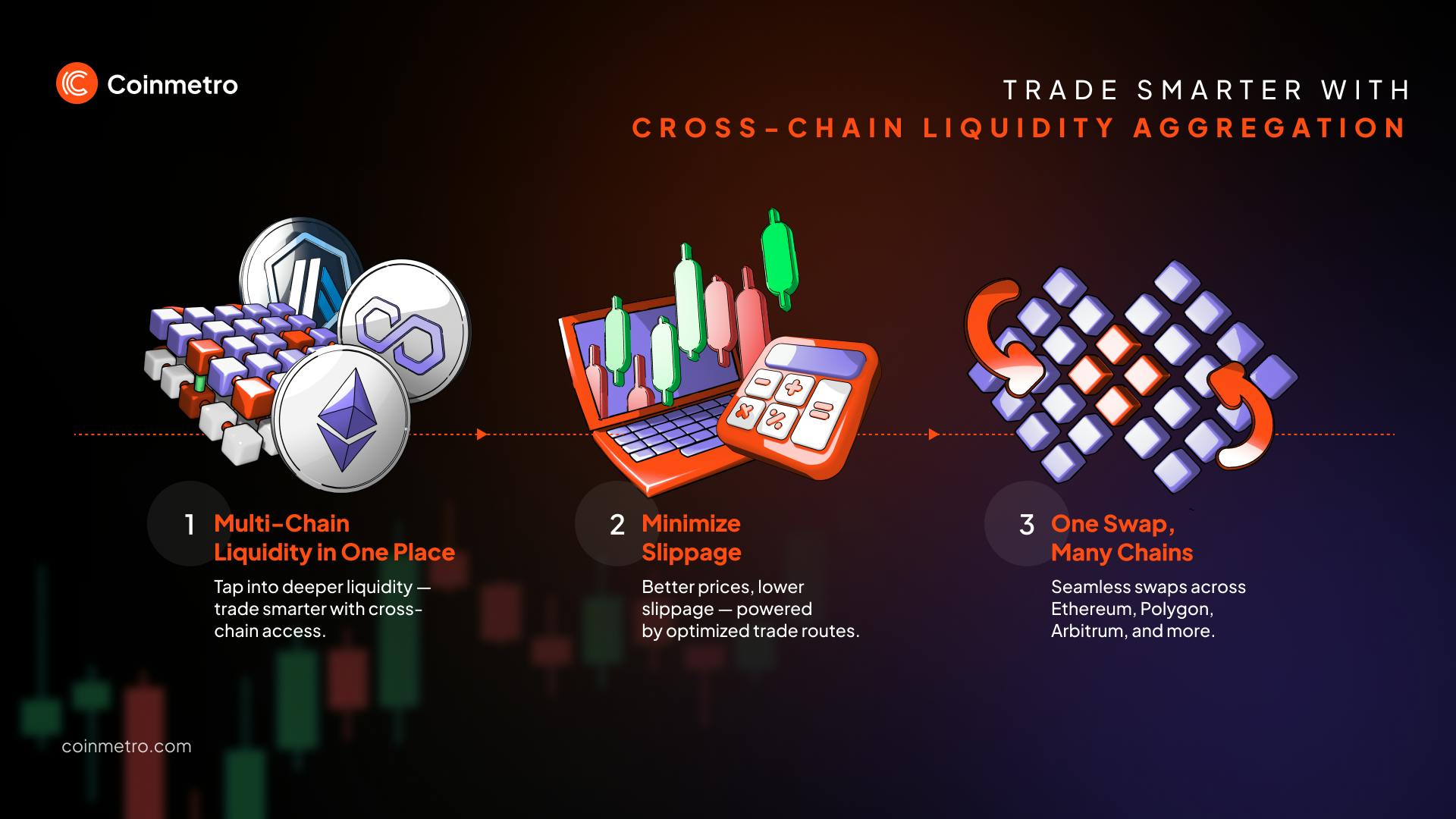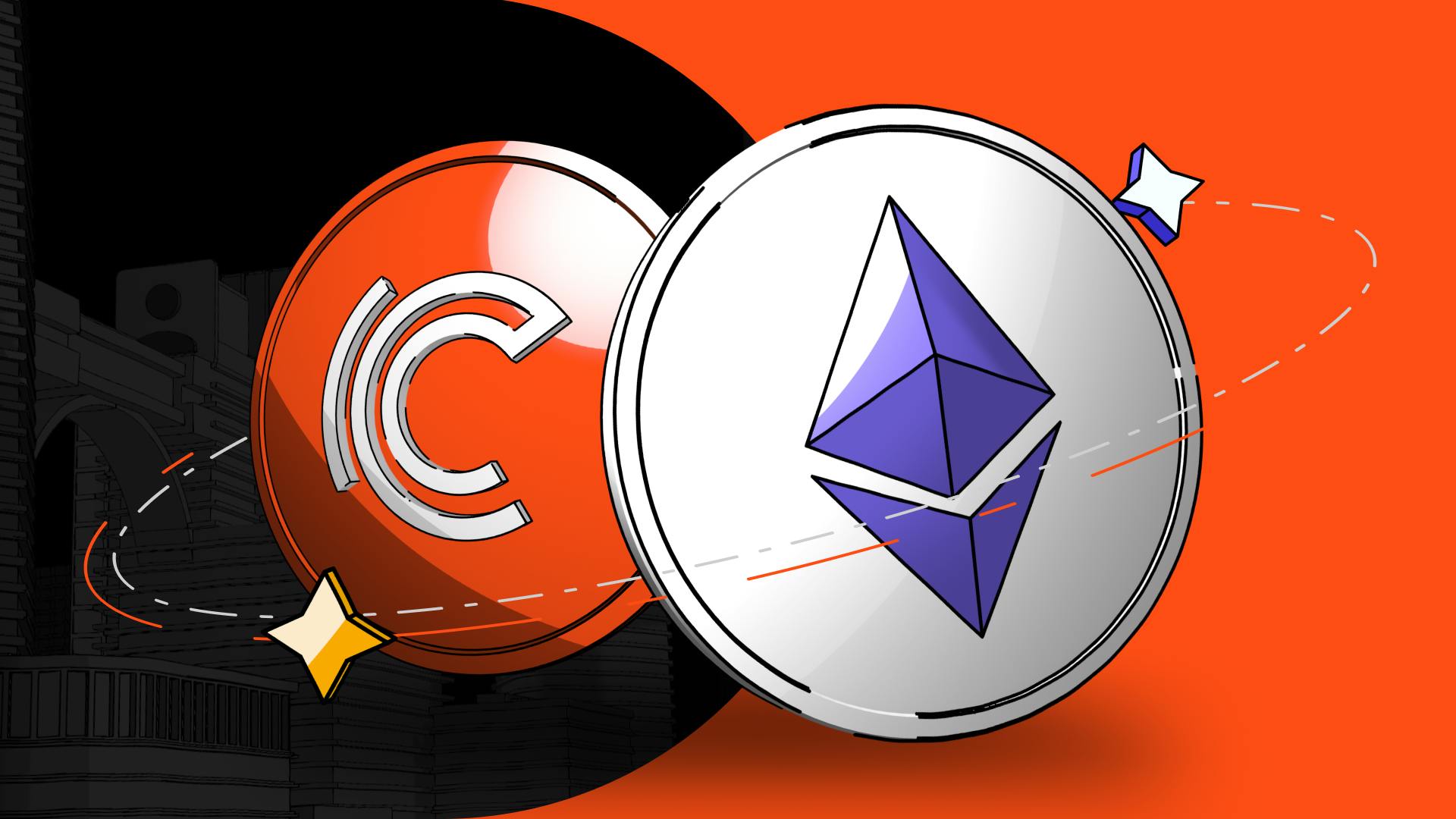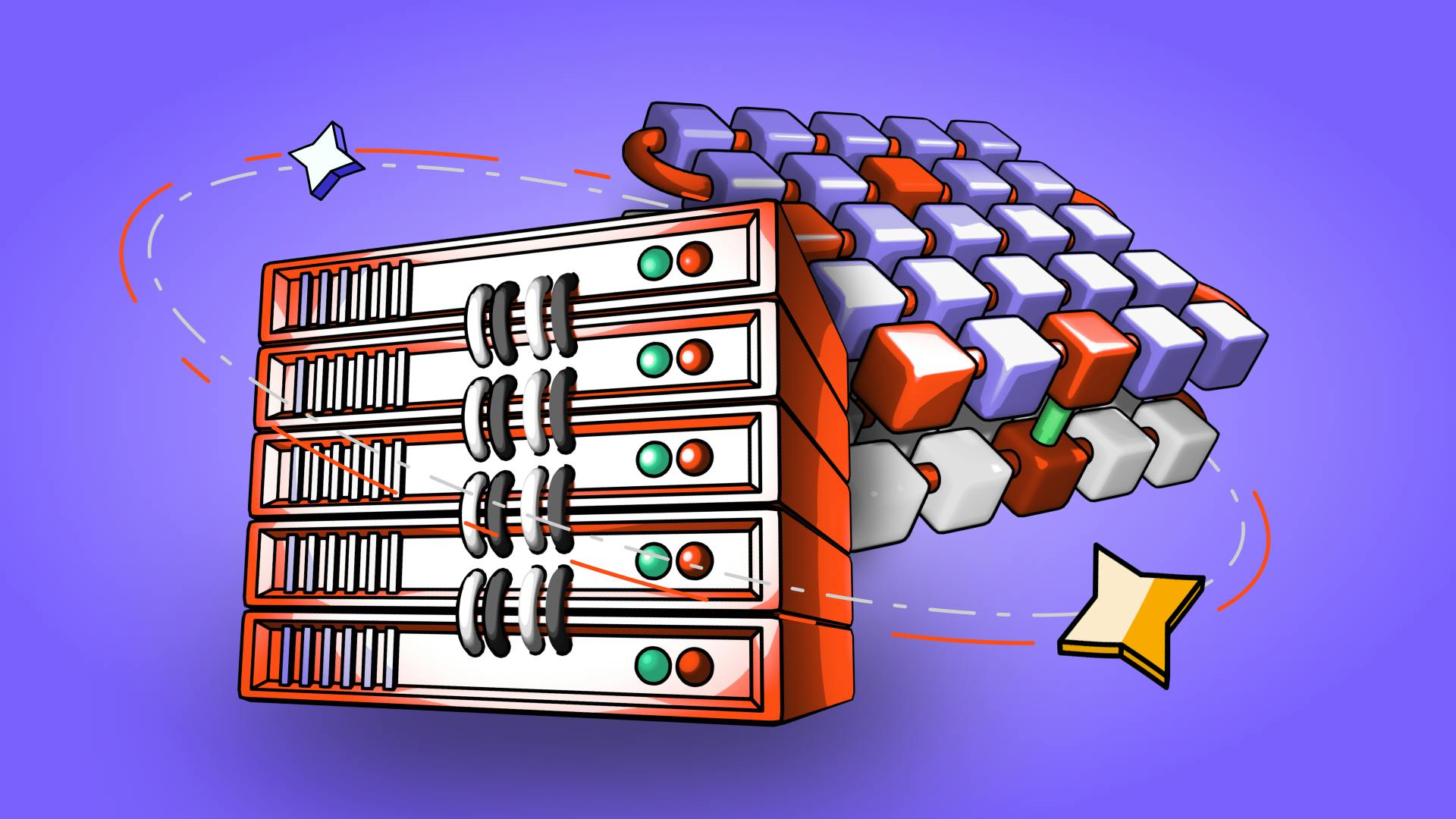Agregadores DEX Multicadeia: Maximizar a Liquidez e Minimizar a Derrapagem
28 de outubro de 2025

by Coinmetro
28 de outubro de 2025
As bolsas descentralizadas (DEXs) transformaram o comércio de ativos digitais ao permitirem transferências diretas entre utilizadores. Eliminam a necessidade de intermediários centrais e baseiam-se na arquitetura blockchain. Esta estrutura oferece maior transparência, integridade dos dados e resistência à adulteração. Além disso, minimiza o risco de custódia. No entanto, as DEXs enfrentam limitações — duas das principais são as restrições de liquidez e a derrapagem, ambas influenciando a velocidade de negociação e a qualidade da execução.
A liquidez reflete a facilidade com que os ativos podem ser comprados ou vendidos sem alterar significativamente os preços. Uma elevada liquidez permite grandes transações com impacto mínimo. Em contraste, a baixa liquidez conduz a spreads mais amplos entre compra e venda e a movimentos bruscos de preço. Isto reduz a eficiência e aumenta o desvio entre a intenção e a realidade do mercado.
A derrapagem ocorre quando o preço de execução de uma transação difere do preço esperado. Costuma surgir em mercados com grande volatilidade ou baixa liquidez. A derrapagem pode reduzir os lucros, especialmente em transações de grande volume ou em estratégias de execução algorítmica.
A funcionalidade multicadeia tornou-se essencial nas finanças descentralizadas. Permite a movimentação de ativos entre diferentes redes blockchain sem fricção. Esta expansão aumenta a liquidez global e reduz o risco de derrapagem. Os agregadores DEX multicadeia desempenham um papel fundamental: reúnem liquidez de várias redes e otimizam o encaminhamento das transações para obter melhores resultados.
Este artigo explica como os agregadores DEX multicadeia maximizam a liquidez e minimizam a derrapagem, melhorando a experiência de negociação nas finanças descentralizadas (DeFi). Vai aprender sobre:
- Compreender os agregadores DEX multicadeia
- O papel da liquidez nas DEXs
- Benefícios para traders e investidores
- Desafios técnicos e soluções
- Futuro dos agregadores DEX multicadeia
Compare: Decentralized Exchanges (DEXs) vs. Centralized Exchanges (CEXs)
Os agregadores de bolsas descentralizadas multicadeia (DEX multicadeia) ligam os utilizadores à liquidez existente em várias redes blockchain. Reúnem o volume de negociação de diferentes DEXs e permitem a troca de ativos entre cadeias sem necessidade de pontes ou intermediários centralizados. O seu objetivo é aumentar a liquidez, reduzir a derrapagem e melhorar a formação de preços, pesquisando vários mercados em simultâneo.
As DEXs tradicionais operam numa única blockchain, o que limita as negociações a ativos nativos dessa rede. Por exemplo, uma DEX baseada em Ethereum só pode suportar tokens ERC-20. Essa limitação fragmenta a liquidez e aumenta o risco de derrapagem.
Os agregadores DEX multicadeia resolvem este problema ao ligar várias blockchains. Os seus motores de roteamento analisam as melhores oportunidades de negociação entre todas as cadeias conectadas. Este processo minimiza a derrapagem, amplia o acesso a diferentes ativos e assegura uma execução mais eficiente. Ao combinar a liquidez de vários ecossistemas, ajudam os utilizadores a negociar de forma mais eficaz e com custos mais baixos.
Vários agregadores DEX multicadeia ganharam destaque no espaço DeFi:
Rango Exchange: Integra mais de 100 DEXs e pontes, garantindo transações multicadeia robustas. A plataforma, de utilização intuitiva, suporta mais de 25 carteiras e destaca-se pela eficiência e confiança.
1inch: Um agregador DEX bem estabelecido que utiliza o algoritmo Pathfinder para encontrar as rotas de troca ideais entre inúmeras DEXs. Oferece alta liquidez, interfaces fáceis de usar e funcionalidades de governança através da 1inch Network DAO.
OpenOcean: Destaca-se na gestão de transações tanto em cadeias EVM como não EVM, ligando mais de 30 blockchains e obtendo liquidez de mais de 1.000 fornecedores. Oferece funcionalidades como ordens sem limite de gás e trocas multicadeia extensas, tornando-se uma escolha versátil.
ParaSwap: Integra múltiplas DEXs para proporcionar trocas eficientes de stablecoins com baixa derrapagem. Suporta várias blockchains, incluindo Ethereum e Optimism, sendo reconhecida pela sua segurança e eficiência no consumo de gás.
Matcha: Construída sobre o protocolo 0x, a Matcha oferece pools de liquidez profundos e funcionalidades avançadas de negociação. Foi concebida para traders profissionais e suporta várias blockchains, proporcionando taxas competitivas e rotas de troca eficientes.
Estas plataformas estão entre as escolhas mais populares devido à sua capacidade de agregar liquidez de múltiplas fontes, otimizar as rotas de negociação e minimizar a derrapagem. Proporcionam experiências de negociação aprimoradas através de uma melhor descoberta de preços, maior eficiência de custos e interfaces intuitivas, tornando-as adequadas tanto para traders iniciantes como experientes.
Descubra as Plataformas de Destaque que Estão a Impulsionar o Crescimento das DeFi

A liquidez refere-se à facilidade com que um ativo pode ser comprado ou vendido no mercado sem afetar o seu preço. Nas bolsas descentralizadas (DEXs), a liquidez é essencial, pois influencia a rapidez e a eficiência com que as transações podem ser executadas. Uma elevada liquidez significa a existência de muitas ordens de compra e venda, permitindo transações mais fluidas e rápidas.
A liquidez influencia significativamente a eficiência das negociações e a experiência geral do utilizador:
Velocidade das transações: Uma elevada liquidez garante que as ordens sejam executadas rapidamente, reduzindo o tempo de espera para os traders.
Estabilidade dos preços: Com liquidez suficiente, as transações de grande volume têm menos probabilidade de causar flutuações significativas nos preços, resultando num ambiente de negociação mais estável.
Menor derrapagem: A derrapagem — a diferença entre o preço esperado de uma transação e o preço efetivamente executado — é minimizada em mercados com alta liquidez, garantindo que os traders obtenham os preços previstos.
Custos reduzidos: Uma elevada liquidez conduz a spreads mais estreitos entre compra e venda (a diferença entre o preço máximo que um comprador está disposto a pagar e o preço mínimo que um vendedor aceita), reduzindo assim os custos implícitos de negociação.
As DEXs multicadeia melhoram a liquidez ao agregar ativos de várias blockchains, oferecendo aos traders um ambiente de negociação mais fluido e eficiente do que as DEXs de cadeia única.
DEXs de cadeia única
Liquidez limitada: As DEXs de cadeia única, como as baseadas em Ethereum, operam dentro de uma única blockchain. Isto limita a liquidez aos ativos disponíveis nessa cadeia específica, o que pode resultar em maior derrapagem e negociações menos eficientes.
Mercados fragmentados: Os traders que precisam trocar ativos entre diferentes blockchains têm de utilizar várias DEXs, o que leva à fragmentação da liquidez e a um processo de negociação mais complexo.
DEXs multicadeia
Liquidez agregada: As DEXs multicadeia combinam liquidez proveniente de várias blockchains, proporcionando um conjunto maior de ativos e melhorando a experiência geral de negociação. Devido à maior liquidez, os utilizadores têm acesso a uma gama mais ampla de tokens e a preços mais vantajosos.
Negociação sem fricção: As DEXs multicadeia facilitam transações entre diferentes blockchains, oferecendo uma experiência de negociação contínua. Os utilizadores não precisam de mover manualmente os ativos entre cadeias, o que reduz a fricção e o tempo de transação.
Execução otimizada de ordens: Os agregadores DEX multicadeia utilizam algoritmos avançados para encontrar as melhores rotas de negociação entre diversos pools de liquidez, minimizando a derrapagem e garantindo que os utilizadores obtenham os melhores preços possíveis para as suas transações.
Obtenha Conhecimento: Principais Soluções de Escalabilidade de Camada 2
Como mencionado, os agregadores DEX multicadeia utilizam roteamento em tempo real para encontrar os melhores preços entre diferentes cadeias. Os seus algoritmos analisam múltiplos pools para escolher a rota de negociação mais eficiente. Isto ajuda a reduzir a derrapagem e melhora a precisão dos preços. A fusão da liquidez reduz os spreads entre compra e venda e torna as negociações mais estáveis. Os traders poupam dinheiro e obtêm melhores resultados ao utilizarem liquidez agregada em vez de fontes isoladas.
As DEXs tradicionais apenas suportam tokens numa única blockchain. Os agregadores eliminam essa limitação ao ligar várias redes. Os utilizadores podem negociar tokens entre diferentes cadeias sem mudar de plataforma nem recorrer a pontes. Esta configuração dá aos traders acesso a mais ativos e melhores oportunidades, apoiando o crescimento das carteiras e transações mais rápidas. Os utilizadores podem reagir rapidamente às variações de preço sem terem de mover fundos manualmente.
Os agregadores DEX multicadeia enfrentam questões técnicas complexas que afetam a segurança e o desempenho. Entre elas estão a comunicação entre cadeias, a compatibilidade entre protocolos e os riscos de transação.
A maioria das blockchains funciona com protocolos únicos e utiliza métodos de consenso distintos. Isso dificulta a partilha de dados ou a verificação de transações entre redes. Sem regras padronizadas, as transações podem falhar ou comportar-se de forma imprevisível entre cadeias.
Para resolver este problema, os desenvolvedores utilizam ferramentas que funcionam como pontes. Estas ferramentas ajudam a traduzir e validar informações entre blockchains. Camadas de mensagens padronizadas e estruturas de roteamento são essenciais para permitir que as diferentes redes funcionem em conjunto.
A movimentação de ativos entre diferentes cadeias aumenta o risco. Ameaças como ataques de repetição, duplo gasto e erros em contratos inteligentes podem crescer a cada transferência. Para manter a segurança, os projetos devem auditar o seu código e utilizar uma encriptação robusta. Revisões por terceiros e programas de recompensas por deteção de falhas ajudam a identificar problemas precocemente. Camadas adicionais de segurança também reduzem o risco durante as trocas de tokens entre cadeias.
Para enfrentar estes desafios, foram desenvolvidas várias soluções e inovações tecnológicas:
Atomic Swaps: Um método criptográfico que permite a duas partes trocar criptomoedas de diferentes blockchains sem necessidade de intermediários. Estas trocas utilizam contratos bloqueados por tempo e hash (HTLCs) para garantir que a transação ocorra totalmente ou não ocorra, evitando trocas parciais ou falhadas.
Pontes e Oráculos Seguros: Desempenham um papel crucial na viabilização de transações multicadeia. As pontes facilitam a transferência de ativos entre diferentes blockchains, enquanto os oráculos fornecem dados externos necessários para que os contratos inteligentes sejam executados corretamente. Garantir a segurança destes componentes é essencial para manter a integridade das interações multicadeia.
Uma das principais tendências é a utilização de algoritmos avançados e inteligência artificial (IA) para melhorar a execução e o roteamento da liquidez. Estes sistemas analisam os pools de liquidez em tempo real para encontrar rotas de negociação mais vantajosas. Como resultado, os utilizadores beneficiam de melhores preços e menor derrapagem.
Outro desenvolvimento é o foco na melhoria da experiência do utilizador. Os agregadores estão agora a concentrar-se em interfaces mais limpas e fluxos de negociação sem fricção. O objetivo é tornar o DeFi mais acessível e intuitivo para participantes não técnicos.
Há também progressos no campo da identidade descentralizada. As plataformas estão a explorar soluções de identidade que melhorem a conformidade sem comprometer a privacidade. Estas ferramentas podem ajudar a cumprir as exigências regulatórias, preservando ao mesmo tempo a natureza aberta do DeFi.
Os agregadores DEX multicadeia podem remodelar os mercados globais ao interligar a liquidez entre diferentes cadeias. Permitem negociações entre ativos que antes estavam isolados, ajudando a unificar a descoberta de preços e a estabilizar os mercados em ecossistemas fragmentados.
Com maior liquidez, os utilizadores beneficiam de spreads mais reduzidos e menor volatilidade. Isso apoia tanto os traders de retalho como os fluxos institucionais, tornando os mercados mais resilientes durante grandes negociações ou ciclos de notícias relevantes.
Estas plataformas também reduzem as barreiras à entrada. Ao eliminar intermediários, tornam os mercados acessíveis a um número maior de pessoas. Esta inclusão financeira pode impulsionar a inovação de produtos, a concorrência e uma participação económica mais ampla.
Ainda assim, a regulamentação continua a ser uma preocupação. As DEXs multicadeia operam num mosaico de regras locais. Muitos países divergem quanto à forma de classificar e supervisionar estas plataformas. Essa incerteza gera riscos legais e atrasa a adoção. Até que surja um quadro regulatório claro, as plataformas devem manter-se flexíveis e proativas em matéria de conformidade. A clareza legal será crucial para desbloquear o capital institucional e alcançar escala.
Os agregadores multicadeia deverão ganhar maior adoção à medida que os utilizadores procuram melhor liquidez e acesso a negociações. As plataformas que cumprirem tanto os padrões de conformidade como de desempenho conquistarão confiança e volume.
À medida que o DeFi e as finanças tradicionais convergem, os agregadores poderão atuar como pontes. Poderão canalizar valor entre sistemas on-chain e off-chain, criando uma estrutura financeira mais unificada. Esta evolução trará mais resiliência, flexibilidade e inclusão tanto aos mercados tradicionais como aos cripto.
▶️ Assista: Como os Agregadores DEX São os Motores de Busca das Negociações em DeFi
Junte-se à comunidade Coinmetro no Discord e Telegram, onde traders e investidores visionários se reúnem para compartilhar conhecimentos, explorar novas oportunidades e mergulhar profundamente em criptomoedas. Se precisar de ajuda, entre em contato com a nossa equipe de suporte ao cliente de classe mundial através do chat ao vivo 24/7 ou por e-mail para hello@coinmetro.com.
Para se tornar um utilizador Coinmetro hoje, Registre-se agora, ou aceda à nossa nova Bolsa se já estiver registrado para experimentar nossa plataforma de negociação premium.
Etiquetas
Artigos relacionados

Influenciadores de Criptomoedas a Seguir em 2024: Quem Está a Moldar o Mercado?
Os influenciadores de criptomoedas desempenham um papel fundamental no mercado de moedas digitais. Eles orientam os investidores com perceções…
9m

Empréstimos e Empréstimos DeFi: Um Guia para Principiantes
As DeFi (Finanças Descentralizadas) utilizam a tecnologia blockchain para oferecer serviços financeiros sem bancos. Plataformas como Ethereum, Solana…
9m

How to Stake Ethereum (ETH) on Coinmetro Fast, Easy, and Securely
Quer ganhar rendimento passivo com o seu Ethereum? Com a Coinmetro, fazer staking de ETH é simples, seguro e ideal para principiantes. Neste guia…
2m

O Futuro das Soluções Descentralizadas de Largura de Banda e Armazenament
A era digital impulsiona a criação de dados, exigindo soluções seguras e escaláveis para a sua gestão. Os sistemas centralizados de largura de banda…
7m